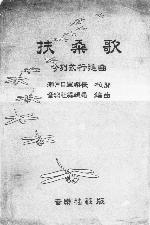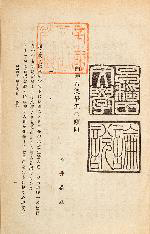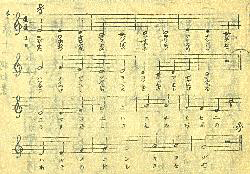![]()
Chapter 2: Art
Section 3: The acceptance of French music
In the last days of the Tokugawa shogunate French style military bands were introduced and the acceptance of French music in Japan began. Hired foreigner Charles Edouard Gabriel Leroux (1851-1926) built the foundation for French style music training in military bands. The military bands provided even the common people with opportunities to enjoy French music through outdoor concerts in Hibiya Park. Meanwhile, at the Tokyo Music School (present day Tokyo University of the Arts Faculty of Music), which played a central in music education at the time, German music was considered more important with a tendency to place less emphasis on French music in academism. However, when impressionist music, as represented by Claude Achille Debussy (1862-1918), arrived, it received passionate support from some literati including NAGAI Kafu (1879-1959), NAITO Aro (1883-1977) and SHIMAZAKI Toson. Music critic OTAGURO Motoo (1893-1979) also contributed to the popularization of French music through his writing and concert activities.
Musical training of military bands
Musical training of military bands
L. Maillart, MURAKOSHI Mei (Tr.), Sakusohōnu jikka daizensho yakubun, Mainichishimbunsha [20-9] 
The military bands became a starting point for the acceptance of French music in Japan, beginning with the trumpet practice of the 1st French military adviser group which came to Japan in 1867. The military reviews of the navy were established based on the British style; however the army continued to use French style trumpet signals. This text is was used as a manual by military bands and was partially translated and published in Japan before official publication in France and other countries in America and Europe. The author, Louis Adolphe Maillart (1837-1894) was a celebrated saxophone performer, and was the head clarinet and saxophone player for the Opera Paris, Republican Guard, etc. The translator MURAKOSHI Mei (birth and death dates unknown) worked on several of the books on French music translated around this time.
Ongakusha henshūkyoku (Ed.), Fusōka, Ongakusha shuppambu, 1912 [特279-258] 
The wind instrument composition Fuso-ka, composed by army military band instructor Charles Edouard Gabriel Leroux in 1885, was designated the military review march for the Japanese army in 1902. The same song also had wind instrument and solo piano performance versions published in France. Leroux came to Japan in 1884 as a member of the 3rd French military adviser group. He formed a training military band and carried out systematic training in fundamentals including music theory, solfeggio, copying scores, and practical techniques for various instruments. He also carried out research on Asian music during his stay in Japan, and after returning to France published the work La musique classique japonaise [780.952-L618m], which is said to be the first text researching Gagaku (ceremonial music of the Japanese imperial court) in France. NAGAI Kenshi (1865-1940), who was instructed by Leroux in the army military band, studied abroad in France in 1903 and trained with the 98th Infantry Regiment of the Army for which Leroux served as captain. After returning to Japan, he was appointed the military bandmaster for the Army Toyama School and worked tireless to ensure the enhancement of the band, becoming a famous military bandmaster.
The reception of impressionist music
NAGAI Kafūu, Seiyō ongaku saikin no ryūkō (Waseda bungaku [2nd](35), pp.1-21 [雑8-40] ) 
NAGAI Kafu figured himself a music aficionado, and it appears that while staying in France, he frequently attended concerts and became familiar with the latest music. This article, which was printed in the Waseda Bungaku in October of 1908, compares and discusses Richard Georg Strauss (1864-1949) of Germany and Claude Debussy (1864-1949) of France as the front line composers of the time, and while continuing to sing the praises of the genius of Struass, the successor of Wilhelm Richard Wagner (1813-1883), also assessed Debussy as having created "a new music which had not been heard throughout the entire European music world until that day".
Japan's first opera
KOMATSU Kōsuke, Kageki hagoromo, Shūbunkan, 1906 [特67-253] 
KOMATSU Kosuke (1884-1966) was a composer, music critic and music teacher who was active from the Meiji to Showa Eras. He formed the Gakuenkai, which researched on opera, together with YAMADA Gen'ichiro (1870-1927) and KOBAYASHI Aiyu (1881-1945) in 1906 and wrote and composed Hagoromo, Japan's first real opera. This text is the piano score for the opera with a foreword by MINAMOTO Takashizu (MORI Ogai). KOMATSU became the editing director for the magazine Ongakukai [雑35-5] in 1908, and from 1920 he went to study composing at a Paris music institute. Among musicians there was a strong tendency to consider only German music as real music, but French music gained attention from an early point, with works including Gendai furansu ongaku (lit. Modern French Music) [564-90].
The development of Musunde Hiraite
Monbushō ongakutorishirabegakari (Ed.), Shōgaku shōkashū 1, Monbushō, 1881 [767.7-M753s] 
Musunde Hiraite is a children's song which was widely loved and written by Jean-Jacques Rousseau (1712-1778) (although there are different views) and originally came to Japan as a hymn. This text was edited by the Ministry of Education Music Research Office and given the title Miwataseba. It became popular as a song during games at kindergarten. In addition, the military song book Daitō Gunka [45-189] published in 1895, included a song title Sentō-ka, which begins "Miwataseba yosetekuru" and this song uses the same melody.













